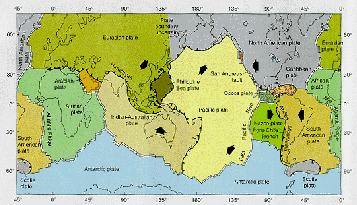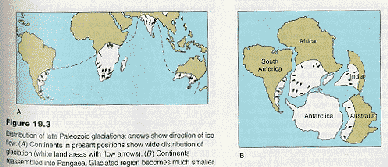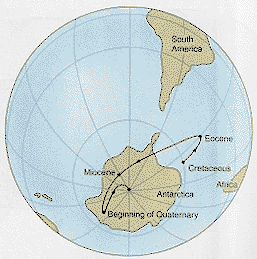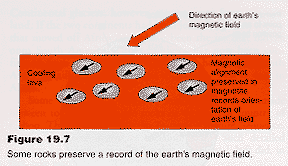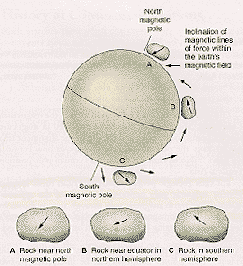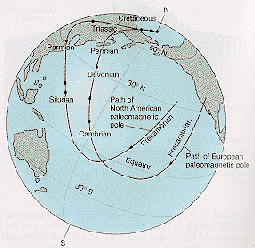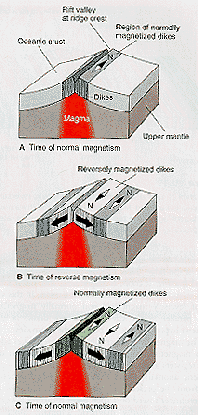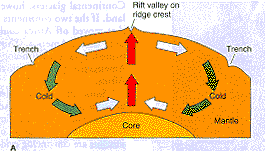|
Early development of plate tectonics: In the 1900's, a German meteorologist by the name of Alfred Wegener was the first to present an argument supporting continental drift. He proposed that the continents were not stationary, but actually moving or drifting away from one another. His primary sources of evidence included the fit of the continents, glacial till deposits, and the apparent shifting of climatic belts over time. His colleagues at the time argued for polar wandering as an explanation of his data. These ideas were not well accepted until later scientists in the 1940's and 50's expanded on these ideas adding to them paleomagnetism, convection currents and sea floor spreading. With all this new evidence, plate tectonic theory became an accepted idea in the 1970's. |
|
|
Wegener noticed that the continents seemed to fit together, not at the continuously changing shoreline, but at the edge to their continental shelves. He derived this hypothesis from the observation that the continents in the southern hemisphere exhibit an identical pattern of rock and fossils known as the "Gondwana sequence". The most logical explanation was that the continents themselves were once parts of a much larger "super-continent" which was named Pangaea. |
|
| A second idea supporting movement of the continents was the glacial till deposits in the southern hemisphere. With the continents in their present positions, the till deposits indicate erratic glacier motion. When the continents are fitted together, they show a much more streamlined motion of the glacier from southern Africa and Northern Australia outward. |
|
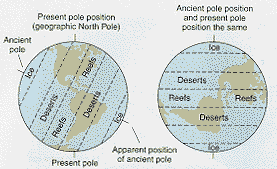
Wegener collected ancient climate information to confirm his glacial data. For the glaciers to have been present with the continents in their current positions, much of the world should have been under ice. But this wasn't the case. Sedimentary rock examination showed a change in climates, and the only possible explanations were continental drift or movement of the poles. |
Here we see the motion of the poles as mapped by Wegener using the sedimentary rock data. |
| Later evidence was given in support of Wegener's ideas. One source of evidence was that of paleomagnetism. When hot magma rises to the earth's surface and cools, the minerals themselves (especially magnetite) become magnetized in alignment with the Earth's magnetic field. |
|
| Rocks that were formed at different places on the Earth's surface have different magnetizations. Using this information, when rock layers were uncovered with a magnetization that did not agree with it's position on the Earth, questions were raised. It was proposed that the Earth's magnetic poles wandered. |
|
| Paleomagnetic data was collected from North America and Europe. Using the alignment of magnetite minerals in the rock layers, the movement of the magnetic poles could be traced through the different geologic periods. |
|
| In the 1960's a gentleman by the name of Harry Hess proposed that not only were the continents moving, but the sea floor was also moving. Motion of the sea floor in a conveyor belt fashion explains the phenomena of the youngest rocks being found only at the mid-ocean ridges, and the rocks get progressively older as you move away from the ridge. If the sea floor is spreading, then clearly the continents could diverge from one another. The rock of the sea floor also exhibited magnetic properties. Not only did the magnetism of these rocks change over time, they completely reversed which supported the motion of the magnetic poles. |
|
| Hess's explanation of the motion of the sea floor was mantle convection. It has been understood that the Earth's mantle behaves plastically. At the ridge crest in the sea floor, hot magma rises because it is less dense than the surrounding magma. When it reaches the surface it cools and hardens becoming the sea floor. As more magma rises, the present sea floor is pushed aside. At plate boundaries, the cold and more dense rock sinks and melts, becoming magma once again. This mantle convection is the driving force for the motion of the sea floor and the continents themselves. |
|
| The picture to the right brings it all together. Here we see mantle convection at work. Magma rises and spreads the sea floor. At the boundary between the plates, the ocean floor sinks, but at the same time is pushing against the continents. At the plates move, most of the geological structures and events we are familiar with occur, including earthquakes and volcanoes. Plate tectonics a major theory explaining the dynamics of our planet Earth and our understanding would not have been the same without it. | 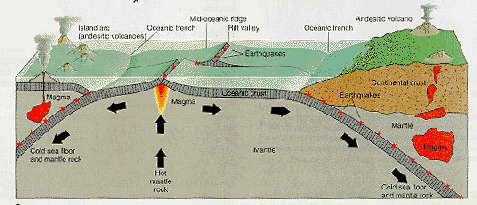 |
